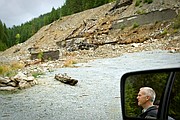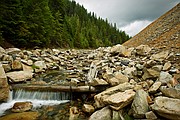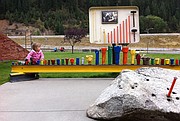Cleaning up the basin
Alecia Warren | Hagadone News Network | UPDATED 15 years, 3 months AGO
Harry Sommers remembers well what the East Fork of Moon Creek looked like a decade ago.
The water, cutting in front of his Moon Gulch home north of Kellogg, would run orange in the spring, the season runoff mixing with tailings from the Silver Crescent mine and mill a mile to the north.
Fish were rare.
“We told the kids not to venture too far out (to the water),” said Sommers, 66. who has lived at the property all his life. He added that when he was young, “the stream had nothing but mine runoff. They were still dumping into the stream.”
Things are different now.
Since the U.S. Forest Service cleaned the mine site and creek as part of Superfund efforts in the Coeur d’Alene river basin, the creek offers a more picturesque scene.
The water gushes clear, tidily rimmed with new boulders and vegetation to stabilize the shore.
Cutthroat and brook trout now call it home.
“It makes you feel better,” Sommers said, as his two Brazilian mastiffs trotted through the water. “Now kids can go out and play.”
The $2.5 million Silver Crescent cleanup site, also called Moon Gulch, is used as a demonstration site of basin cleanup efforts, said Jeff Johnson, Forest Service project manager at the site.
On top of basic cleanup efforts at Moon Gulch there was additional habitat restoration, Johnson said, which will preserve the cleanup by helping natural resources thrive again.
“It’s a good example of a successful cleanup,” Johnson during a media tour of Moon Gulch, located on Forest Service land. “This provides a good example of what worked and what didn’t work.”
Thursday’s tour hosted by the Environmental Protection Agency, which included finished, continuing and potential cleanup sites, revealed what cleanup activities can achieve, as well as issues that still need to be tackled under the proposed $1.34 billion cleanup plan.
The plan would extend cleanup in the upper basin, and could stretch into the next 100 years depending on funding, said EPA Project Manager Bill Adams.
Projects would include reducing metal concentrations in surface water and soil, as well as protecting completed sites from recontamination.
The potential of the plan is evident at Moon Gulch, Adams said.
“We’ve had questions, ‘What will it look like when we’re done with the projects?’” Adams said. “And this is what (that) would be. There’s a lot of work that went into it.”
Before work started on Moon Gulch in 1999, the defunct mining site was a barren, rust-colored valley with remnants of tailing ponds, which Johnson showed with photos.
No vegetation could grow there, he said. It was useless except for locals tearing it up with ATVs.
“That made the problem worse, obviously,” he said.
Over two years, the Forest Service cleared the valley and creek bed of tailings, rock waste and soil contaminated with metals like lead, cadmium and arsenic.
Roughly 130,000 cubic yards of waste are now safely secured on-site in a buried repository.
The site has been transformed into lush wetlands, with ponds that can sustain amphibious life.
“We’re standing in what used to be the lowest tailing impoundment,” Johnson said, standing among thick wetland vegetation. “We would have been 5 to 12 feet under mine tailings at this point.”
Following the $1.9 million cleanup, the agency conducted a $500,000 habitat restoration.
Johnson pointed out the 85 fishery habitats installed along the meandering creek.
“Everything you see here was intentional, designed and thought about,” Johnson said, glancing over the logs and boulders placed along the banks. “Now with all the structures we put in, I’d like to think it’s a very preferred place for fish to go.”
Other Superfund sites can look the same, he said.
“Many sites, as impacted as they are, can be fixed just like this one,” he said.
Even, Adams said, heavily contaminated areas like several mining sites in the Nine Mile Creek Watershed just outside Wallace.
The worst of these is Success silver mine and mill.
The now defunct mine had been dumping mining waste since the early 1900s, and now boasts looming mountains of rust colored tailings and waste rock, some 150 feet high.
The East Fork of Nine Mile Creek lies only a few feet away. The water has an orange stain from the 200 pounds of metals that dump into it each day.
“Success is the most significant source of metal loading of all Nine Mile Creek,” Adams said.
The paltry vegetation at the site isn’t alone at risk. Adams pointed out where a campfire was still smoking a few yards from the tailing piles.
“There’s is a lot of recreation activity out here,” he said. “These are pretty hot (high in metal content), and public exposure to that is really significant.”
Under the proposed cleanup plan, all of the contaminated material would be removed, he said, though the details of cleanup will be sorted out after more site analysis.
The Success site, he added, is roughly the same size as Moon Gulch.
“Just picture Moon Gulch overlaying this,” he said. “It would be about the same.”
The public comment period on the proposed cleanup plan is open until Nov. 24.
After reviewing and responding to comments, EPA will issue its final cleanup decision in a ROD Amendment, which Adams forecasted to happen next March.
The Forest Service is open to giving guided tours of the Moon Gulch site, Johnson said.
To arrange group tours, call Johnson at 765-7447.
“Just come and take a look,” he said. “This is the positive example of what we’ve done.”
ARTICLES BY ALECIA WARREN
Tribe's property taxes canceled
After a meeting with Coeur d'Alene Tribe officials today, Kootenai County commissioners voted unanimously to cancel all property taxes on reservation land from the past four years.
In hot water
Idaho DEQ says temps are too warm for trout
We like our fish cooked... But not before we catch them.
Past issues
Old charge blocks weapons permit
A Hayden resident believes his rights were violated when he was disqualified from obtaining a concealed weapons permit because of a felony charge from over 40 years ago.













